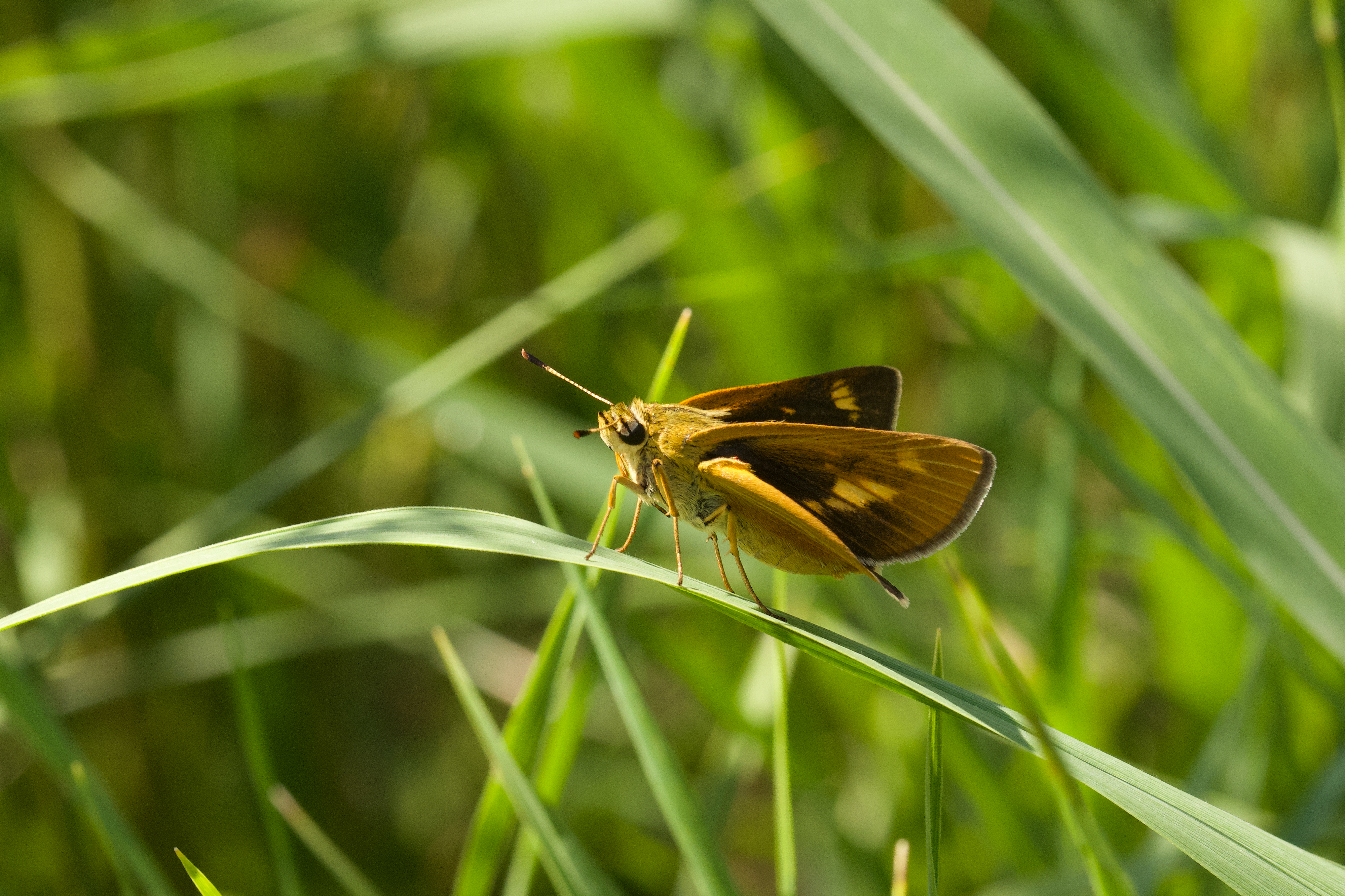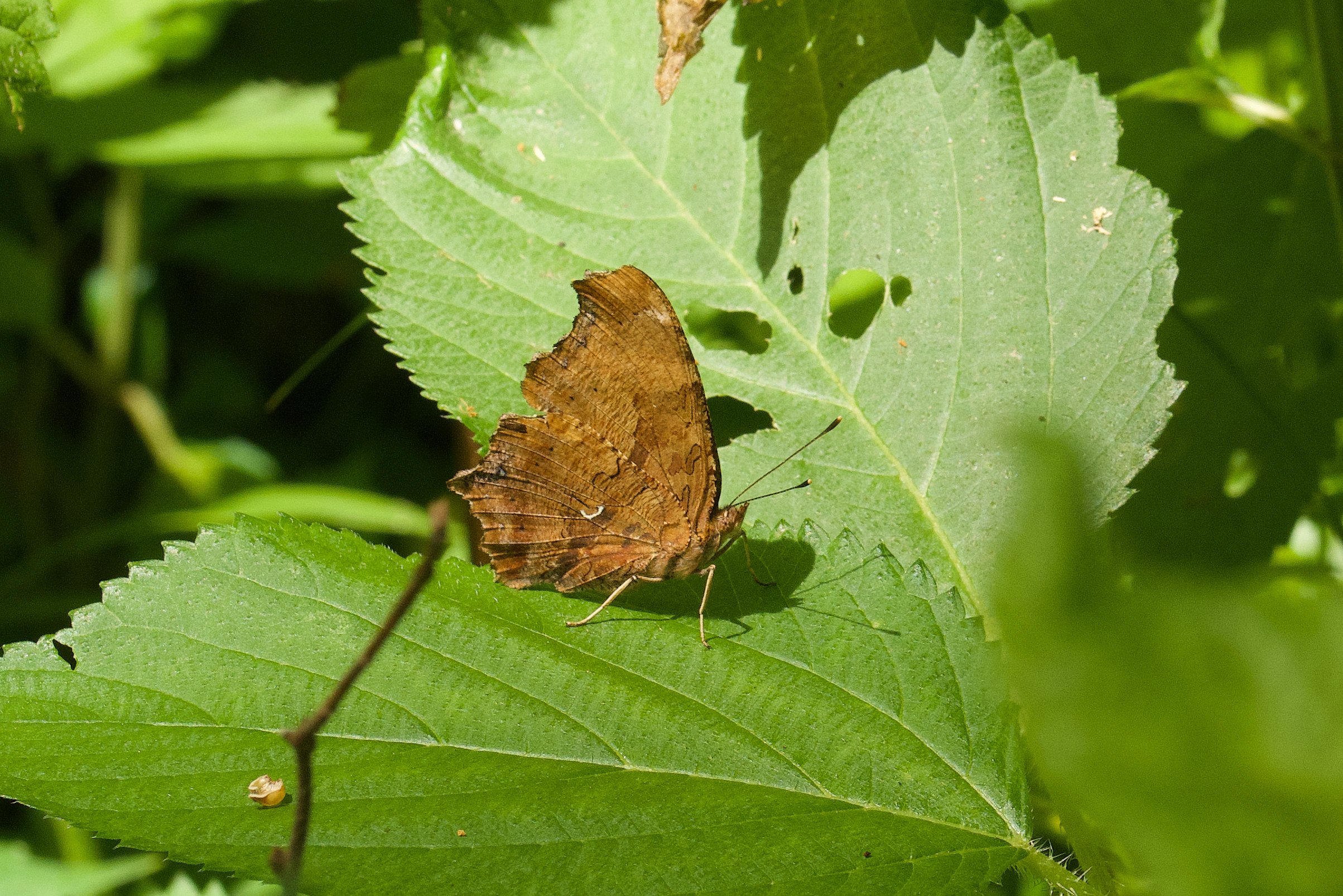Lest anyone be confused the “Big Year” is not a solo effort. That was never more apparent than yesterday (July 1) when Jonathan Nikkila (hooray – you get pictures), my wife Jen and I went to Fontenelle Forest, Kinter’s Ford SWMA, Four Mile Creek SWMA and Table Rock SWMA.
We started at Fontenelle Forest where JoAnne Langabee had clued me in on where to find Northern Pearly Eyes and Tawny Emperors. It had rained earlier that morning so the Bladdernut and Indian trails were kind of slippery when we set out. Things did not start out that well as there was little activity, probably due to the early (by butterfly time) hour, wet conditions and lingering overcast. But after about an hour these conditions remedied themselves and we had a sudden flurry of activity. First Jen saw a Northern Pearly Eye (Lethe anthedon) when Jon and I were investigating elsewhere and put us on that butterfly. Shortly thereafter Jon spotted a Tawny Emperor (Asterocampa clyton) and we all gathered around to admire it as it posed for pics. Pleased with ourselves we started back and Jen or Jon pointed out an anglewing (Polygonia sp.) which turned out to be Eastern Comma (P. comma). So with three new “Big Year” species we headed back to the cars having also seen a Zebra Swallowtail, a half dozen Great Spangled Fritillaries and Eastern Tailed Blues to numerous to count.

So we next headed south to Kinter’s Ford SWMA in western Richardson county where Matt Brust (now Dr. Matthew Brust of Chadron State College) had discovered Byssus Skippers (Problema byssus) back in 2006 when those were the first records for that species from the state. We looked around there for the better part of an hour during which time Jon found a dead skipper on the ground (who does that?). Jen and I were back at the car rehydrating when Jon got our attention to come back and look at a skipper he had located in the grass while taking a work related phone call. It was indeed a Byssus skipper, and while still on the phone Jon managed to get a few pics before the skipper, tiring of the unwanted attention, flew away. “Big Year” species # 4.


So we then drove the 6 miles to Four Mile Creek SWMA to admire the Butterfly Milkweed in the area. It had rained there earlier in the day as well and between the mud in the parking lot and the flowers there were butterflies everywhere. As soon as we got out of the cars we all spotted a Snout Butterfly (Libytheana carinenta) prowling the mud puddles in the parking area – “Big Year” species # 5.

Thinking we might be able to find a second generation Horaces Duskywing we then headed to Table Rock SWMA where I’d seen them in good numbers back in 2003. We prowled the oak woodland margins for the better part of an hour, finding only Wood Nymphs and Anglewings. Finally on the way back to the parking area about 50 yards from the car we spooked up a smaller anglewing which I netted and determined to be a Gray Comma (Polygonia progne). So we released him/her back to the wild and called it a day with 6 new “Big Year” species and a year to date total of 87.
So how many would I have seen on my own – no way to tell. Maybe all six, maybe just a couple. The point being the results of this years “Big Year” search would not be possible without support of a village of people both supplying locations to look and assisting in the effort in person. My thanks to all of them.
Byssus Skipper – This is a recent addition to our state’s butterfly fauna, being first discovered by Dr. Matthew Brust in 2006. It’s range is restricted by the distribution of its larval hostplant Eastern Grama Grass (Tripsacum dactyloides) which in our state is southeastern Nebraska. It flies in a single brood from late June through mid July and has not been found to stray far from its hostplant. To date it has been recorded from only two sites in Richardson and Otoe counties.

Snout Butterfly – This butterfly cannot survive Nebraska winters but is becoming a regular stray that likely breeds here. Larvae feed on Hackberries (Celtis sp.). As a stray they can show up anywhere. We have records from early May to mid October.

Eastern Comma – This butterfly overwinters as an adult and as a result can be seen the entire season from early April to mid November. During that time frame there are multiple broods with larvae feeding on nettles and hops. Adults frequent open woodlands and woodland margins but are also be found in urban settings. They are easily confused with Question Marks and Gray Commas (see May 8 post for keys to separating them). The Eastern Comma has been found statewide with the exception of the more arid regions of western Nebraska.


Gray Comma – This species is easily confused with the other two sibling species in the eastern part of the state. Once again consult the May 8 post for identification keys. Larvae of this species feed on Gooseberries and Currants (Ribes sp.). As with all Polygonia species adults overwinter. Multiple broods of adults have been found from late April to late October. As with the Eastern Comma the Gray Comma is absent from the more arid areas of western and southwestern Nebraska.

Tawny Emperor – The Tawny Emperor is a larger brighter version of it’s cousin the Hackberry Emperor. Both are generally found in the vicinity of their larval hostplants Hackberry trees (Celtis sp.). In Nebraska it is largely restricted to southeastern third of the state with an additional population in the Sioux county canyonlands. It is likely double brooded with populations peaking in late June and late August.


Northern Pearly Eye – Populations of this woodland denizen normally peak in late June/early July. However records from late May to early September indicate an occasional second flight may occur. Records are scattered across the eastern two thirds of the state. Larvae feed on a variety of grasses.


So once again thanks to everyone supporting this project!!
A couple of other comments – Fresh Sleepy Oranges are once again flying in my yard – the progeny of the migrants/strays that arrived in late May (see June 2 post).
I was looking through iNaturalist a while back for Wood Nymphs (Cercyonis pegala) and did not see any. Did I miss them? While not as sexy as Regal Fritillaries they are another native grassland specialist that is not nearly as widespread as they once were. We were happy to see them at Kinter’s Ford and Table Rock SWMAs.
